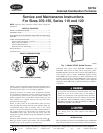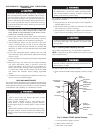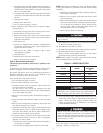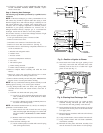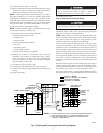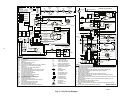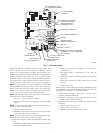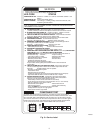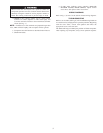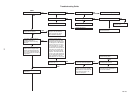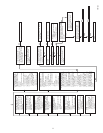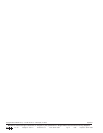
10. Clean flame sensor with fine steel wool
11. Remove old sealant from center panel and collector box flange
and apply new sealant to collector box flange and reinstall on
center panel, making sure all 8 screws are secure.
NOTE: A releasing agent such as PAM cooking spray or equiva-
lent (must not contain corn or canola oil, aromatic or halogenated
hydrocarbons or inadequate seal may occur) and RTV sealant
(G.E. 162, 6702, or Dow-Corning 738) are needed before starting
installation. DO NOT substitute any other type of RTV sealant.
G.E. 162 (P771-9003) is available through RCD in 3-oz tubes.
12. Reinstall relief box and inducer assembly.
NOTE: If inducer assembly gasket is damaged, use RTV sealant
to seal inducer assembly to collector box.
13. Reconnect wires to the following components:
a. Blocked vent safeguard switch.
b. Inducer motor.
c. Pressure switch.
d. Limit overtemperature switch(es).
e. Gas valve.
f. Hot surface ignitor.
g. Flame-sensing electrode
h. Flame rollout switch(es), if applicable.
14. Reinstall vent connector to furnace flue collar. After fully
assembling vent connector to furnace flue collar, securely
fasten vent connector to flue collar with 2 field-supplied,
corrosion-resistant, sheet metal screws located 180 degrees
apart and midway up the collar.
15. Turn electrical power and gas to ON.
16. Set thermostat and check furnace for proper operation.
17. Verify blower airflow and speed changes between heating and
cooling.
18. Check for gas leaks.
Never use a match or other open flame to check for gas leaks.
Use a soap-and-water solution. A failure to follow this
warning could result in fire, personal injury, or death.
19. Replace control door.
Step 4—Electrical Controls and Wiring
There may be more than 1 electrical supply to unit. Check
accessories and cooling unit for additional electrical supplies.
The electrical ground and polarity for 115-v wiring must be
maintained properly. Refer to Fig. 5 for field wiring information
and to Fig. 6 for furnace wiring information.
NOTE: If the polarity is not correct, the STATUS LED on the
control will flash rapidly and prevent the furnace from heating.
The control system also requires an earth ground for proper
operation of the control and flame-sensing electrode.
The 24-v circuit contains an automotive-type, 3-amp fuse located
on the control. (See Fig. 7.) Any shorts of the 24-v wiring during
installation, service, or maintenance will cause this fuse to blow. If
fuse replacement is required, use ONLY a 3-amp fuse. The control
LED will display status code 24 when fuse needs to be replaced.
With power to the unit disconnected, check all electrical connec-
tions for tightness. Tighten all screws on electrical connections. If
any smoky or burned connections are found, disassemble the
connection, clean all parts, strip wire, and reassemble properly and
securely.
Reconnect electrical power to the unit and observe unit through 1
complete operating cycle. Electrical controls are difficult to check
without proper instrumentation; if there are any discrepancies in
the operating cycle, contact your dealer and request service.
The control in this furnace is equipped with an LED status light to
aid in installation, servicing, and troubleshooting. It can be viewed
Fig. 5–Heating and Cooling Application Wiring Diagram
A98521
115-V FIELD-
SUPPLIED
DISCONNECT
AUXILIARY
J-BOX
24-V
TERMINAL
BLOCK
THREE-WIRE
HEATING-ONLY
FIVE WIRE
NOTE 1
NOTE 2
FIELD-SUPPLIED
DISCONNECT
CONDENSING
UNIT
TWO
WIRE
FURNACE
C
O
N
T
R
O
L
R
G
C
WCR GY
GND
GND
FIELD 24-V WIRING
FIELD 115-, 208/230-, 460-V WIRING
FACTORY 24-V WIRING
FACTORY 115-V WIRING
208/230- OR
460-V
THREE
PHASE
208/230-V
SINGLE
PHASE
BLOWER DOOR SWITCH
WHT
BLK
WHT
BLK
NOTES: Connect Y-terminal in furnace as shown for proper blower operation.
Some thermostats require a "C" terminal connection as shown.
If any of the original wire, as supplied, must be replaced, use
same type or equivalent wire.
W
Y
GND
THERMOSTAT
TERMINALS
1.
2.
3.
5



